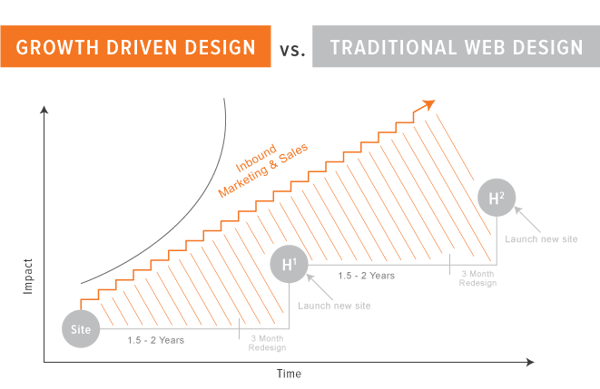What is Growth-Driven Design and can how it be used as well as what are the business benefits?
Want to watch rather than read?
Our Chief Executive explains what growth-driven design is in this video:
Pardon references to The B2B Marketing Lab, this video was created before we merged with MPULL to form Huble Digital.
"What we have come to accept as the standard way we approach building and maintaining a website is riddled with systematic risk and is costing your business time, money and opportunity."
- Luke Summerfield, HubSpot
Traditional website redesign is broken
As your website meets your prospects before any of your employees do, it is 100% the most important component in your marketing activity.
Therefore, ensuring that it is full of high-quality content and responsive on both desktop and mobile is absolutely key to generating new enquiries and customers.
Gone are the days where a simple, static ‘brochure’ type website would bring you leads and enquiries. In today’s world, it is not enough to have a website which is never updated, fails to introduce new high-quality content on a regular basis, and provides no means for interested searchers to engage with your business on a level other than a big ‘contact us’ button.
If you find yourself in the position where your ‘static’ and ‘traditional’ website is no longer generating you leads, business enquiries or any form of engagement, a complete redesign may be the solution.
But what does a redesign involve?
Traditional website redesign projects are complicated, expensive – and time-consuming. With a traditional website redesign, you spend month after month trying to rectify your unsatisfactory website - all while costs are escalating and your under-performing website live.
So you want to avoid all that - and you want a number of things:
- You want your new website now
- You want to get rid of the old website as soon as possible
- You don’t want to spend a large lump-sum on a new one
- You know what you want it to look like
- You want to be able to easily add new pages to it
With this in mind, traditional website redesign is not for you. In fact, traditional website redesign is broken – and businesses can no longer afford to take that approach.
Using a traditional approach, after launch, a website typically has no major updates for one or two years. How on earth can a business maximise performance and lead generation activity if its best marketer and salesperson is left on the bench?
There is an alternative. It's called Growth-Driven Design.
Opt for a Growth-Driven Design approach
Growth-Driven Design offers an alternative, smarter and more potent approach to the website redesign process. Instead of recreating your website in its entirety, you identify your highest-value pages and launch with them first for your new website.
Essentially, you launch with the smallest - but most effective - website you can and as quickly as possible.

With Growth-Driven Design, you focus continuously on:
- Improving your website through data, analytics and user-behaviour
- Minimising expenses and risks
- Preventing deadlines being extended
- Introducing new, high-quality content on a regular basis
- Building your website based on actionable data - providing a data-driven design
Growth-Driven Design represents a tremendous opportunity for your business to modify its existing website into one that really does work as the most powerful lead generating part of the business - just as it should!
If you want a super in-depth explanation of Growth-Driven Design from the pioneer himself - Luke Summerfield - check out the video below!
So how does Growth-Driven Design work?
Before delving into our GDD website development process, you need to first work out your goals, come up with a strategy to achieve those goals and work out who you're trying to reach. In other words, your target audience.
If you want to find out more about buyer personas - including what they are and how they can be used in your marketing and sales activity - check out our blog on buyer personas here.
Once you've done the above, you can get started...
The strategy
Website strategy
The first thing you need to spend time on is strategy. Ask yourself the following:
What is wrong with your current website?
Why is it not performing as it should be?
What is it you want from a new website and how will it help you to achieve your business goals?
At this stage of the process, we use everything from business offering questionnaires to buyer personas workshops to understand exactly what you want from a new website, as well as what your audience wants to see.
SEO
When building a new website, SEO is THE most important thing to focus on. If your website isn't optimised for search engines, no amount of fancy features, tools, colours or branding will help people to find it.
To that end, we run reports to understand how well (or badly) your site is performing. Using the data, we can then identify where improvements can be made. However, as redesigning a website can affect its SEO, we carefully manage the process and map keywords to new pages before flipping the switch.
Design
Once your web pages have been search engine optimised, you can start thinking about the stylistic elements of your website.
- Website design guidelines:
From your brand colours and fonts, through to what type of images and icons you use throughout your site, we'll start off by trying to get a really good understanding of what 'look and feel' you are trying to create with your new website.
- Wireframes:
Sometimes it's hard to visualise what a web page will look like until it's live. Different people have different visions, but it can take a lot of time and effort to build a website template in the first place. We use wireframes and software to provide you with previews of your web pages before we start the actual build. This means we only start working on templates and the build once you are completely happy with it, saving you time and effort along the way, as well as avoiding delays.
The launchpad
Development
The aim is to get you a brand-new, lead-generating website in just 13 weeks - but this depends on the size and complexity of your website.
The idea - as mentioned previously - is to put live the smallest but most strategically effective website you can launch in the shortest possible period of time.
Taking this approach, you can streamline the website development process, continue to generate traffic and leads for your business and utilise the data acquired in the process to inform future page creation. Once the launchpad site is live, you can then focus on building and growing the site over time, rather than trying to build it all at once and it taking 12 months, rather than 3.
Content
As well as developing your website, you also need to focus on its content. The content on your website not only affects SEO - but also the user experience.
Ask yourself...
-
Does your content explain your products and services well?
-
Does it educate and inform users without selling or being too pushy?
-
Does it provide visitors with the information they need, when they need it?
Clearly there's a lot to consider out of just developing your website and making sure your products and services are visible!
Continuous growth
Data collection
Here's where GDD and traditional website design differ greatly. GDD is all about iterative and smart development. It's about using data to guide the project and achieve the best possible results.
Your new launchpad website is live and collecting data from the moment it goes live, and you need to pay close attention to the analytics. What pages are visitors engaging with? What pages are delivering conversions? What pages are driving new customers?
This is also an opportunity to look at things like the user experience and the personalisation of web pages to improve engagement. You might find that - from your analytics - users are staying on one page longer than another. What is that page doing that the other isn't?
Growing your website
Once your launchpad website is live, you need to then start growing your website on a monthly and quarterly basis to ensure it's the best it can possibly be.
You might want to add new web pages or blogs. You might even want to include new tools, surveys, questionnaires, eBooks or videos.
However, no matter what you include, you must make sure that it is search engine optimised and prioritised based on what's performing well on the website.
At no stage should you attempt to add all of your web pages at once. Not only will this make it difficult to measure what is and isn't working, it'll also be difficult for your team to manage in addition to their day-to-day activities.
Lastly, regularly review progress in relation to your original goals to ensure everything is on the right track (you're redesigning your website for a reason, remember?)
Setting monthly goals alongside the web pages you are planning to incorporate will ensure that everything you do is based on a specific objective.








.png)





